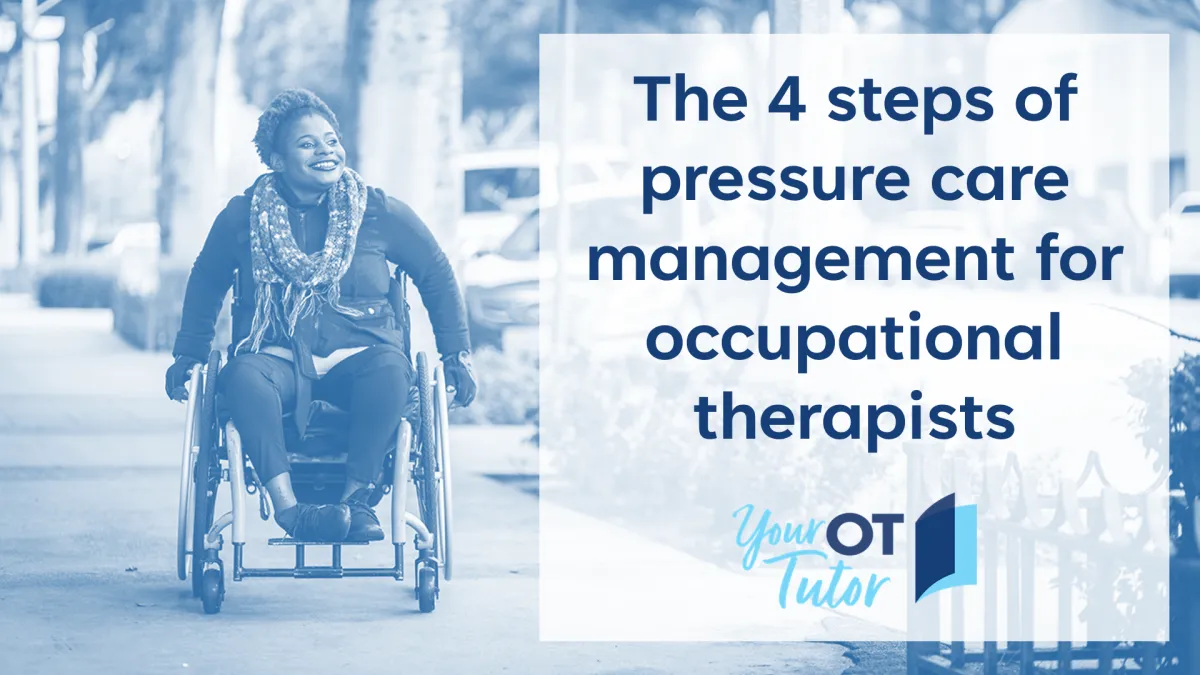THE YOUR OT TUTOR BLOG
Articles on important topics for occupational therapists...


THE 4 STEPS OF PRESSURE CARE MANAGEMENT FOR OCCUPATIONAL THERAPISTS
Occupational therapists play an important role in pressure care management for clients at risk of developing pressure injuries, but where should you start, and what should you cover?
The OT approach can be described in 4 steps:
1. Assess risk factors
2. Prescribe Assistive Technology (AT) and strategies
3. Educate clients and carers
4. Evaluate the effectiveness of your approach
Let’s explore these 4 steps in more detail.
1. Assess risk factors
The first step OTs need to follow is to identify which clients are at risk of developing pressure areas in the first place, and what their individual risk factors are; this then allows us to be more targeted in the interventions and education we provide.
It can be helpful to use the PEO model (Law et al., 1996) to explore risk factors:
Person factors – this could include older age, nutritional status, incontinence, sensation, skin integrity and weight.
Environment factors – consider what cushions or mattresses are already in place, or if the weather is hot and humid.
Activity factors – consider how many hours the person spends in one position, whether they can reposition themselves, and how they transfer (consider shearing forces that may occur).
Standardised tools like the Waterlow Scale or Braden Scale can be helpful for taking a systematic approach to the assessment of risk factors like these.
2. Prescribe AT and strategies
Once you have identified what the person’s individual risk factors are, you can be more targeted in your treatment approach. You may include:
Assistive technology prescription – such as the obvious things like cushions and mattresses, as well as items like padded commode seats and air-filled booties.
Strategies such as positioning and activity schedules – this could include setting limits for how long a person should spend seated in a wheelchair or chair, and establishing regular toileting regimes to minimise incontinence and the increased pressure injury risk this causes.
3. Educate clients and carers
It is important to know that this won’t be a ‘one-size-fits-all’ situation. The content of your education needs to be tailored to the individual, as well as your delivery. This means taking into consideration the client and carer’s level of health literacy and their preferred learning modalities. An education handout may be needed, but don’t just give it to the client and hope for the best – talk them through it, highlighting the points that are most relevant to them. Providing videos can also be a great way to supplement written and verbal education.
Your education content should include topics like:
What the person’s risk factors are and why they need to be managed
How to spot a developing pressure injury and the importance of regular skin checks
How any prescribed AT works, especially when regular maintenance is involved (such as monitoring air cushions)
How they can manage their daily activities and routines in a way that minimises their pressure injury risks
4. Evaluate effectiveness
As with any OT intervention, we need to be completing follow-up after any treatment session to ensure our approach has been effective. This could involve informal discussions with clients and carers about whether recommended routines have been achievable, or the use of standardised assessments to determine the effectiveness of a particular piece of AT. Here’s some things you should be checking:
Is the client/carer able to describe what the person’s risk factors are and how to complete a skin check?
Is the client/carer able to setup and monitor any prescribed AT (e.g. ensuring gel is evenly distributed in a cushion, knowing how to trouble-shoot issues when a pressure mattress starts beeping!)?
Have they been able to follow recommended schedules for maximum sitting times, or is it not sustainable with their level of supports or other commitments?
Are support workers following your recommendations for correct manual handling to minimise shearing forces during transfers?
There are many things we need to consider at each step of the process. One way to ensure our approach is evidence-based, is to apply research evidence from Clinical Practice Guidelines. There is a free quick reference guide available as a starting point, but also consider purchasing the full guidelines for more detail; you can find these guides here: https://www.internationalguideline.com/
If you’d like to find out more about how OTs can use clinical practice guidelines to improve their practice in relation to pressure care management, come along to the April 2023 Your OT Tutor Journal Club session (or purchase the recording from May 2023). Here is the link you need: https://yott.au/journal_club_pressure_care_april_2023
If you found this post helpful, keep following Your OT Tutor for more tips, resources and CPD opportunities!
References: Law, M., Cooper, B. A., Strong, S., Stewart, D., Rigby, P., & Letts, L. (1996). The person-environment-occupation model: A transactive approach to occupational performance. Canadian Journal of Occupational Therapy, 63, 9-23.
#YourOTTutor #OccupationalTherapy #ClinicalEducation #EvidenceBasedPractice #JournalClub #PressureCare #PressureInjury






